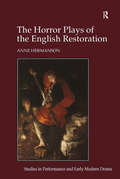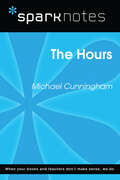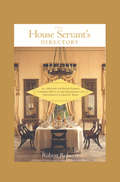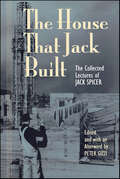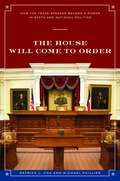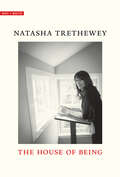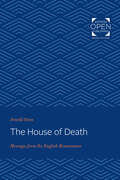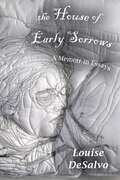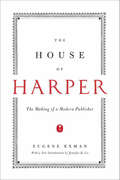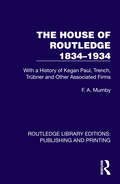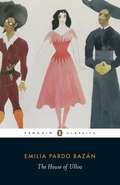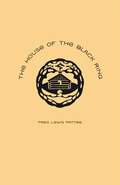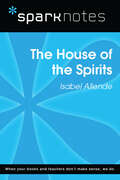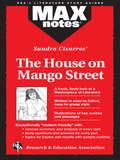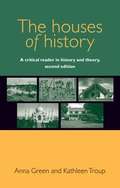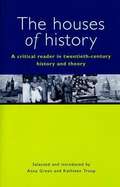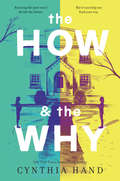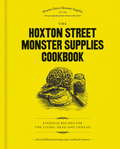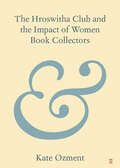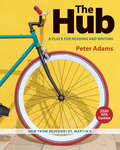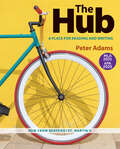- Table View
- List View
The Horn of Africa Diasporas in Italy: An Oral History
by Gabriele ProglioThis book delves into the history of the Horn of Africa diaspora in Italy and Europe through the stories of those who fled to Italy from East African states. It draws on oral history research carried out by the BABE project (Bodies Across Borders: Oral and Visual Memories in Europe and Beyond) in a host of cities across Italy that explored topics including migration journeys, the memory of colonialism in the Horn of Africa, cultural identity in Italy and Europe, and Mediterranean crossings. This book shows how the cultural memory of interviewees is deeply linked to an intersubjective context that is changing Italian and European identities. The collected narratives reveal the existence of another Italy – and another Europe – through stories that cross national and European borders and unfold in transnational and global networks. They tell of the multiple identities of the diaspora and reconsider the geography of the continent, in terms of experiences, emotions, and close relationships, and help reinterpret the history and legacy of Italian colonialism.
The Horror Plays of the English Restoration (Studies in Performance and Early Modern Drama)
by Anne HermansonA decade after the Restoration of Charles II, a disturbing group of tragedies, dubbed by modern critics the horror or the blood-and-torture villain tragedies, burst onto the London stage. Ten years later they were gone - absorbed into the partisan frenzy which enveloped the theatre at the height of the Exclusion Crisis. Despite burgeoning interest, until now there has been no full investigation into why these deeply unsettling plays were written when they were and why they so fascinated audiences for the period that they held the stage. The author’s contention is that the genre of horror gains its popularity at times of social dislocation. It reflects deep schisms in society, and English society was profoundly unsettled and in a (delayed) state of shock from years of social upheaval and civil conflict. Through recurrent images of monstrosity, madness, venereal disease, incest and atheism, Hermanson argues that the horror dramatists trope deep-seated and unresolved anxieties - engaging profoundly with contemporary discourse by abreacting the conspiratorial climate of suspicion and fear. Some go as far as to question unequivocally the moral and political value of monarchy, vilifying the office of kingship and pushing ideas of atheism further than in any drama produced since Seneca. This study marks the first comprehensive investigation of these macabre tragedies in which playwrights such as Nathaniel Lee, Thomas Shadwell, Elkanah Settle, Thomas Otway and the Earl of Rochester take their audience on an exploration of human iniquity, thrusting them into an examination of man’s relationship to God, power, justice and evil.
The Hours (SparkNotes Literature Guide Series)
by SparkNotesThe Hours (SparkNotes Literature Guide) by Michael Cunningham Making the reading experience fun! Created by Harvard students for students everywhere, SparkNotes is a new breed of study guide: smarter, better, faster.Geared to what today's students need to know, SparkNotes provides:chapter-by-chapter analysis explanations of key themes, motifs, and symbols a review quiz and essay topics Lively and accessible, these guides are perfect for late-night studying and writing papers.
The House Servant's Directory: A Monitor For Private Families (American Antiquarian Cookbook Collection)
by Graham Russell Hodges Robert RobertsRobert Roberts' The House Servant's Directory, first published in 1827 and the standard for household management for decades afterward, is remarkable for several reasons: It is one of the first books written by an African American and issued by a commercial press, and it was written while Roberts (ca. 1780-1860) was in the employ of Christopher Gore (1758-1827), a former senator from and governor of Massachusetts (and ancestor of the novelist Gore Vidal). Gore Place, where Roberts worked from 1825 to 1827, is one of the grandest neoclassical mansions built in America. Not only was the extraordinary set of recommendations that Roberts made about relations between servants and their masters unique for its time, but his many recipes for cleaning furniture and clothing and for purchasing, preparing, and serving food and drink for small and large dinners are also still useful today. As portrayed in Graham Hodges' introduction, Roberts' own story is a unique window into the work habits and thoughts of America's domestic workers and into antebellum African American politics. Of particular note is Roberts' contribution to the emergence of new self-perceptions of black manliness. Written at a time when male Americans in general were reconsidering the construction of masculinity, Roberts' advice to his fellow servants fostered black dignity for work that few felt merited respect, and his counsel to employers on proper treatment of their servants insisted on their humanity and respect for their skills.
The House That Jack Built: The Collected Lectures of Jack Spicer
by Jack SpicerThe House That Jack Built collects for the first time the four historic talks given by controversial poet Jack Spicer just before his early death in 1965. These lively and provocative lectures function as a gloss to Spicer's own poetry, a general discourse on poetics, and a cautionary handbook for young poets. This long-awaited document of Spicer's unorthodox poetic vision, what Robin Blaser has called "the practice of outside," is an authoritative edition of an underground classic.Peter Gizzi's afterword elucidates some of the fundamental issues of Spicer's poetry and lectures, including the concept of poetic dictation, which Spicer renovates with vocabularies of popular culture: radio, Martians, and baseball; his use of the California landscape as a backdrop for his poems; and his visual imagination in relation to the aesthetics of west-coast funk assemblage. This book delivers a firsthand account of the contrary and turbulent poetics that define Spicer's ongoing contribution to an international avant-garde.
The House Will Come to Order
by Michael Phillips Patrick L. CoxIn a state assumed to have a constitutionally weak governor, the Speaker of the Texas House wields enormous power, with the ability to almost single-handedly dictate the legislative agenda. The House Will Come to Order charts the evolution of the Speaker’s role from a relatively obscure office to one of the most powerful in the state. This fascinating account, drawn from the Briscoe Center’s oral history project on the former Speakers, is the story of transition, modernization, and power struggles. Weaving a compelling story of scandal, service, and opportunity, Patrick Cox and Michael Phillips describe the divisions within the traditional Democratic Party, the ascendance of Republicans, and how Texas business, agriculture, and media shaped perceptions of officeholders. While the governor and lieutenant governor wielded their power, the authors show how the modern Texas House Speaker built an office of equal power as the state became more complex and diverse. The authors also explore how race, class, and gender affected this transition as they explain the importance of the office in Texas and the impact the state’s Speakers have had on national politics. At the apex of its power, the Texas House Speaker’s role at last receives the critical consideration it deserves.
The House of Being (Why I Write)
by Natasha TretheweyAn exquisite meditation on the geographies we inherit and the metaphors we inhabit, from Pulitzer Prize winner and nineteenth U.S. poet laureate Natasha Trethewey “Searching and intimate, this impresses.”—Publishers Weekly In a shotgun house in Gulfport, Mississippi, at the crossroads of Highway 49, the legendary highway of the Blues, and Jefferson Street, Natasha Trethewey learned to read and write. Before the land was a crossroads, however, it was a pasture: a farming settlement where, after the Civil War, a group of formerly enslaved women, men, and children made a new home. In this intimate and searching meditation, Trethewey revisits the geography of her childhood to trace the origins of her writing life, born of the need to create new metaphors to inhabit “so that my story would not be determined for me.” She recalls the markers of history and culture that dotted the horizons of her youth: the Confederate flags proudly flown throughout Mississippi; her gradual understanding of her own identity as the child of a Black mother and a white father; and her grandmother’s collages lining the hallway, offering glimpses of the world as it could be. With the clarity of a prophet and the grace of a poet, Trethewey offers up a vision of writing as reclamation: of our own lives and the stories of the vanished, forgotten, and erased.
The House of Death: Messages from the English Renaissance
by Arnold SteinOriginally published in 1986. In The House of Death, Arnold Stein studies the ways in which English poets of the sixteenth and seventeenth centuries imagined their own ends and wrote of the deaths of those they loved or wished to honor. Drawing on a wide range of texts in both poetry and prose, Stein examines the representations, images, and figurative meanings of death from antiquity to the Renaissance. A major premise of the book is that commonplaces, conventions, and the established rules for thinking about death did not prevent writers from discovering the distinctive in it. Eloquent readings of Raleigh, Donne, Herbert, and others capture the poets approaching their own death or confronting the death of others. Marvell's lines on the execution of Charles are paired with his treatment of the dead body of Cromwell; Henry King and John Donne both write of their late wives; Ben Jonson mourns the death of a first son and a first daughter. For purposes of comparison, the governing perspective of the final chapter is modern.
The House of Early Sorrows: A Memoir in Essays
by Louise DeSalvoWINNER OF THE IASA BOOK AWARD!AMERICAN BOOK AWARD WINNER!As the child of children of immigrants, Louise DeSalvo was at first reluctant to write about her truths. Her abusive father, her sister’s suicide, her illness. In this stunning collection of her captivating and frank essays on her life and her Italian-American culture, Louise DeSalvo centers on her beginnings, reframing and revising her acclaimed memoiristic essays, pieces that were the seeds of longer collections, to reveal her true power as a memoirist: the ability to dig ever deeper for personal and political truths that illuminate what it means to be a woman, a second-generation American, a writer, and a scholar. Each essay is driven by a complex inquiry that examines the personal, familial, social, ethnic, and historical dimensions of identity. Collectively, they constitute a story significantly different from DeSalvo’s memoirs when they first published, where the starkness of their meaning became blunted by material surrounding them. DeSalvo has also restored material written and then deleted—experiences she was too reticent to reveal before, in writing about her sister’s suicide, her husband’s adultery, her own sexual assault. The essays also include new material to shift the ballast of an essay as her life has changed significantly through the years. The House of Early Sorrows is a courageous exploration not only of the DeSalvo’s family life and times, but also of our own.
The House of Harper: The Making of a Modern Publisher
by Eugene ExmanAn updated edition of this definitive history of Harper—a fascinating look into the history of American letters from the unique perspective of one of the country’s most distinguished and enduring publishers—now with a new introduction that brings the book up to the present day. From Moby Dick to Huckleberry Finn—but not Alice in Wonderland, which was rejected—The House of Harper is a sweeping trip through American letters, offering anecdotes and stories about authors from Charles Dickens, Herman Melville, and Mark Twain to Thomas Wolfe, Aldous Huxley, and Edna St. Vincent Millay.
The House of Mirth (SparkNotes Literature Guide Series)
by SparkNotesThe House of Mirth (SparkNotes Literature Guide) by Edith Wharton Making the reading experience fun! Created by Harvard students for students everywhere, SparkNotes is a new breed of study guide: smarter, better, faster.Geared to what today's students need to know, SparkNotes provides:chapter-by-chapter analysis explanations of key themes, motifs, and symbols a review quiz and essay topics Lively and accessible, these guides are perfect for late-night studying and writing papers.
The House of Routledge 1834–1934: With a History of Kegan Paul, Trench, Trübner and Other Associated Firms (Routledge Library Editions: Publishing and Printing)
by F. A. MumbyOriginally published in 1934, The House of Routledge, 1834-1934, was published for the company’s centenary. It tells the story of George Routledge and how he forged his way to the forefront of publishing by ‘sheer indomitable energy’. One of the objects of the work was to place on record the crowded story of his life. Turning back many forgotten or half-forgotten pages of literary and publishing history – with their glimpses of bygone haunts; of buccaneering practices in the bad old days before copyright brought protection at long last to English and American authors alike; of “Yellow Backs” and other Victorian libraries. It also covers the fortunes of other associated publishing houses of the time.
The House of Ulloa
by Emilia Pardo Bazán Paul O'PreyThis rich and unforgettable story of sexual intrigue and political scheming, written by the Spanish feminist and intellectual Emilia Pardo Bazan, deserves recognition as one of the great nineteenth-century novels. The House of Ulloa follows pure and pious Father Julián Alvarez, who is sent to a remote country estate to put the affairs of the marquis, an irresponsible libertine, in order. When he discovers moral decadence, cruelty and corruption at his new home, Julián's well-meaning but ineffectual attempts to prevent the fall of the House of Ulloa end in tragedy. The House of Ulloa is the finest achievement of Emilia Pardo Bazán, a prolific writer, feminist, traveller and intellectual, and one of the most dynamic figures of her time.Fans of Zola or Hardy will enjoy the novel's rich naturalism, which combines gothic elements with evocative descriptions of Spanish customs and the countryside. At the same time, the novel evokes the social comedy of a Dickens or Thackeray with its biting social satire, frank exposure of sexual mores, and gentle mockery of its innocent hero-priest.
The House of the Black Ring: A Romance of the Seven Mountains
by Fred Lewis Pattee Julia Spicher Kasdorf Joshua R. BrownFred Lewis Pattee, long regarded as the father of American literary study, also wrote fiction. Originally published in 1905 by Henry Holt, The House of the Black Ring was Pattee’s second novel—a local-color romance set in the mountains of Central Pennsylvania. The book’s plot is driven by family feud, forbidden love, and a touch of the supernatural. This new edition makes this novel accessible to new generations of modern-day readers. General readers will find in The House of the Black Ring a thriller that preserves details of rural life and language during the late nineteenth century. Scholars will read it as an expression of cultural anxiety and change in the decades after the Civil War. An introduction by poet and essayist Julia Spicher Kasdorf situates the novel within the context of social and literary history, as well as Pattee’s own biography, and provides a compelling argument for its importance, not only as a literary artifact or record of local customs, but also as a reflection of Pattee’s own story intertwined with the history of Penn State at the turn of the twentieth century. Joshua Brown draws on his expertise in Pennsylvania German ethno-linguistics to interpret the dialect writing and to give readers a clearer view of the customs and regionalisms depicted in the book.
The House of the Black Ring: A Romance of the Seven Mountains
by Fred Lewis PatteeFred Lewis Pattee, long regarded as the father of American literary study, also wrote fiction. Originally published in 1905 by Henry Holt, The House of the Black Ring was Pattee’s second novel—a local-color romance set in the mountains of Central Pennsylvania. The book’s plot is driven by family feud, forbidden love, and a touch of the supernatural. This new edition makes this novel accessible to new generations of modern-day readers. General readers will find in The House of the Black Ring a thriller that preserves details of rural life and language during the late nineteenth century. Scholars will read it as an expression of cultural anxiety and change in the decades after the Civil War. An introduction by poet and essayist Julia Spicher Kasdorf situates the novel within the context of social and literary history, as well as Pattee’s own biography, and provides a compelling argument for its importance, not only as a literary artifact or record of local customs, but also as a reflection of Pattee’s own story intertwined with the history of Penn State at the turn of the twentieth century. Joshua Brown draws on his expertise in Pennsylvania German ethno-linguistics to interpret the dialect writing and to give readers a clearer view of the customs and regionalisms depicted in the book.
The House of the Spirits (SparkNotes Literature Guide Series)
by SparkNotesThe House of the Spirits (SparkNotes Literature Guide) by Isabel Allende Making the reading experience fun! Created by Harvard students for students everywhere, SparkNotes is a new breed of study guide: smarter, better, faster.Geared to what today's students need to know, SparkNotes provides:chapter-by-chapter analysis explanations of key themes, motifs, and symbols a review quiz and essay topics Lively and accessible, these guides are perfect for late-night studying and writing papers.
The House on Mango Street (Maxnotes Literature Guides)
by Elizabeth CheslaREA's MAXnotes for Sandra Cisneros' The House on Mango Street MAXnotes offer a fresh look at masterpieces of literature, presented in a lively and interesting fashion. Written by literary experts who currently teach the subject, MAXnotes will enhance your understanding and enjoyment of the work. MAXnotes are designed to stimulate independent thought about the literary work by raising various issues and thought-provoking ideas and questions. MAXnotes cover the essentials of what one should know about each work, including an overall summary, character lists, an explanation and discussion of the plot, the work's historical context, illustrations to convey the mood of the work, and a biography of the author. Each chapter is individually summarized and analyzed, and has study questions and answers.
The Houses Of History: A Critical Reader In History And Theory, Second Edition
by Anna Green Kathleen TroupThe houses of history is a clear, jargon-free introduction to the major theoretical approaches employed by historians. This innovative critical reader provides accessible introductions to fourteen schools of thought, from the empiricist to the postcolonial, including chapters on Marxist history, Freud and psychohistory, the Annales, historical sociology, narrative, gender, public history and the history of the emotions. Each chapter begins with a succinct description of the ideas integral to a particular theory. The authors then explore the insights and controversies arising from the application of this model, drawing upon debates and examples from around the world. Each chapter concludes with a representative example from a historian writing within this conceptual framework. This newly revised edition of the highly successful textbook is the ideal basis for an introductory course in history and theory for students of history at all levels.
The Houses of History: A Critical Reader in Twentieth-century History and Theory
by Anna Green Kathleen TroupEvery piece of historical writing has a theoretical basis on which evidence is selected, filtered, and understood. This is as true of scientific empiricism as it is of poststructuralism. The Houses of History provides a comprehensive introduction to the twelve schools of thought which have had the greatest influence on the study of history in the twentieth century. Ranging from Empiricism to Postcolonialism, Marxism to the Ethnohistorians, each chapter begins with an introduction to the particular school, the main protagonists, the critics, and is followed by a useful section of further readings. From the classic, such as G.R. Elton's "England Under the Tudors" and E.P. Thompson's "The Making of the English Working Class," to the recent, such as Henrietta Whiteman's "White Buffalo Woman" and Judith Walkowitz's "City of Dreadful Delight," the diverse selections collected here bring together the leading historians and theorists of the century. Comprehensive and accessible to undergraduates,The Houses of History is ideally suited to classroom use.
The How & the Why
by Cynthia HandCassandra McMurtrey has the best parents a girl could ask for; they’ve given Cass a life she wouldn’t trade for the world. She has everything she needs—but she has questions, too. Like, to know who she is. Where she came from. Questions her adoptive parents can’t answer, no matter how much they love her. But eighteen years ago, someone wrote Cass a series of letters. And they may just hold the answers Cass has been searching for.Alternating between Cass’s search for answers and letters from the pregnant teen who placed her for adoption, this emotionally resonant narrative is the perfect read for fans of Nina LaCour and Jandy Nelson.
The Hoxton Street Monster Supplies Cookbook: Everyday recipes for the living, dead and undead
by Hoxton Street Monster Supplies LimitedFor hundreds of years, the Hoxton Street Monster Supplies shop has been supplying quality goods for the monster community from its premises in east London - and this, its classic recipe book, has been in use for just as long.Now, for the first time, it has been adapted for use by humans as well as monsters. So whether you're entertaining trolls, hosting a vampire soirée or expecting zombies round for tea, you can make delicious treats to suit every occasion.- Fallen out with a friend? Bake them some 1000-year Curse Cookies!- Want to woo a zombie? Try our After-Gorging Breath Mints!- Unexpected ogre guests? Make our Fresh Maggot Brownies or Spiced Earwax Pie!With recipes and handy hints for monster housekeeping, this classic tome is an essential addition to every home, lair, cave, swamp or fiery pit.
The Hoxton Street Monster Supplies Cookbook: The Monster's Cookbook
by Hoxton Street Monster Supplies LimitedFor hundreds of years, the Hoxton Street Monster Supplies shop has been supplying quality goods for the monster community from its premises in east London - and this, its classic recipe book, has been in use for just as long.Now, for the first time, it has been adapted for use by humans as well as monsters. So whether you're entertaining trolls, hosting a vampire soirée or expecting zombies round for tea, you can make delicious treats to suit every occasion.- Fallen out with a friend? Bake them some 1000-year Curse Cookies!- Want to woo a zombie? Try our After-Gorging Breath Mints!- Unexpected ogre guests? Make our Fresh Maggot Brownies or Spiced Earwax Pie!With recipes and handy hints for monster housekeeping, this classic tome is an essential addition to every home, lair, cave, swamp or fiery pit.
The Hroswitha Club and the Impact of Women Book Collectors (Elements in Publishing and Book Culture)
by Kate OzmentThe Hroswitha Club was a group of women book collectors who met from 1944–2004 in the Eastern United States. Despite the fame of individual members like Henrietta Bartlett or Mary Hyde Eccles, there is no sustained study of the Club's work and legacy. This Element makes this history broadly accessible and focuses on how members shared knowledge and expertise and provided a space for legitimacy and self-growth in a period where women's access to formal education and academic institutions was limited. By making this network visible through an examination of archival records, library catalogs, and pamphlets, this project positions the Club as a case study for a more thorough examination of the ways that intersectional identities can make visible or obscure whose intellect, money, and resources have shaped the study of rare books in the United States.
The Hub with 2020 APA Update: A Place for Reading and Writing
by Peter AdamsPeter Adams, founder of the Accelerated Learning Program (ALP), introduces The Hub: A Place for Reading and Writing, the first and only hybrid digital and print course materials developed specifically for corequisite and ALP first-year writing courses. The Hub is based on innovative, sound, and widely replicated research into best practices for improving developmental student outcomes. The high-quality instructional materials have been carefully developed and thoroughly class-tested to support students of varying skill levels in first-year composition and corequisite courses. In addition, The Hub offers the unparalleled instructor support that only Peter Adams can provide. This flexible digital resource available through Macmillan Learnings Achieve platform, and accompanied by a print text, provides all of the course materials you need to support every learner in corequisite composition. From planning to implementation, The Hub is THE destination for everything you need for your first-year corequisite composition or ALP course.
The Hub with 2020 APA and 2021 MLA Updates: A Place for Reading and Writing
by Peter AdamsThis ebook has been updated to provide you with the latest guidance on documenting sources in MLA style and follows the guidelines set forth in the MLA Handbook, 9th edition (April 2021). Success in college composition opens the door to future success in your college career and beyond. Make The Hub your destination for all of the support you need to succeed in college composition, whether it’s help with reading, writing, research, grammar, or even advice on balancing school, life, and work.

